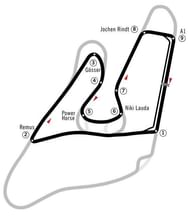The Austrian Grand Prix, or more formally, the Grosser Preis von Österreich, begins tomorrow, the 19th of June, with the first free practice session at 1:30 p.m. IST. Qualifying will begin at 5:30 p.m. IST on the 20th, with the race following 24 hours later.
The track in Spielberg, Austria is the third-shortest in Formula One behind Monaco and Brazil. Only 4.3km long, it is the shortest in terms of lap time, which is down to several high speed straights at the high-altitude track. Spielberg, where the track is located, is in the mountains of Styria, known for its slopes and for being a skiing destination.
There are 9 turns at the track, with 4 opportunities for overtaking. The Red Bull Ring is peculiar in that it is built in the mountains, which leads to sharp uphill and downhill regions on the track. There is a stark 60m range between the highest and lowest points at the Ring, which also leads to four high-speed stretches, two of which are DRS activated zones.
DRS, which is entirely unrelated to its cricket counterpart, is the Drag Reduction System, an overtaking aid for drivers. According to regulation, if a driver is within one second of another and within a DRS designated zone, he may activate the DRS, which alters the angle of the rear wing flap, providing an aerodynamic boost.
A DRS activated zone in a high speed sector of the track will give drivers an added advantage on the narrow straights at the Red Bull Ring. However, with 9 turns, this might be a problem due to the reduced airflow on the second car, which will mean that the driver of the trailing car will need to pick a different ‘line’ to drive in to move out of the ‘dirty air’ zone behind the first.
The turns
Turn 1, the Castrol Edge, turns onto the longest straight of the race – with drivers reaching speeds of up to 300mph here.
Turn 2 is the easiest point of the track to overtake, because it is a hairpin – it is also the highest point of the track – which means that a quick downhill slope, one of the track’s high speed straights follows immediately after. Turn 3 has been described by several drivers, including Red Bull Racing’s own Daniel Ricciardo, as the trickiest of all. Coming at the end of a quick downhill stretch, drivers are forced to use downhill braking, and are prone to mounting the kerb at this point.
The sector following this is the highest-speed sector of all, and the most technically demanding for drivers. Braking distances are very short here, on a completely downhill section. Turn 6 is a sharp, narrow right and the stretch is named for home Formula One icon Niki Lauda.
Turn 8, named for late German F1 driver Jochen Rindt, is the fastest corner on the track, sloping off to the outside. It is at this point that the highest G-force is felt by drivers, and it is extremely physically apparent.. especially on the neck.
Turn 9 is the final turn of the track, still going downhill, and a driver could easily veer off the the track – especially in rainy conditions....
… and here’s the expected weather in Spielberg this weekend:
Looks like the wet tires will be out this weekend.


